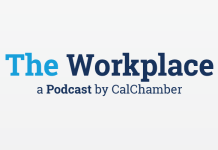In this episode of The Workplace podcast, CalChamber Associate General Counsel Matthew Roberts and CalChamber Senior Policy Advocate Robert Moutrie discuss potential changes coming to the Workplace Violence Prevention Standards for General Industry.
Workplace violence prevention continues to be top of mind for California employers, even though the standard took effect in July 2024. The standard is complex and includes annual obligations for employers.
Changes to these standards now in the works with Cal/OSHA’s Standards Board could further complicate this area of the law and compliance hurdles for employers, Roberts says, even as they work to hone prevention plans mandated by Senate Bill 553.
With SB 553 in place as law, regulators now have the latitude to refine and enhance the language of those standards within the Labor Code, developing a draft proposal through the advisory committee process before ultimately taking the changes to the board for final approval, Moutrie adds.
What Is a Workplace Hazard?
Moutrie notes that the legislation set the stage for the current process by outlining broad requirements in the Labor Code that could later be adjusted, such as adding expanded definitions of the specific types of hazards and what qualifies as a workplace violence incident.
“One of the areas they’re looking at adding very specific details is what’s considered a workplace violence hazard. And that’s important because if the regulation says a certain thing is a workplace violence hazard, then you, as an employer, have an obligation to change or address that hazard,” Moutrie says.
Some of the proposed language the advisory committee is considering includes a list of workplace hazards that could create new and often unavoidable burdens for many employers when it comes to mitigation, including working alone, frequent contact with the public, being open late, and working around valuables or goods. These overly broad definitions would have an outsized impact for businesses like convenience stores, retail establishments, bars and restaurants, to name a few.
“Obviously, taken together, a bunch of these things could create an unsafe scenario you might want to address, but individually, they are not a hazard by themselves, right?” Moutrie says. He adds that initial feedback seems to favor moving away from the overly board or ambiguous language in this area.
Proposed Staffing Increases
Among the suggestions under consideration for the draft language are proposed prohibitions on employees confronting unruly customers or those they suspect of stealing merchandise.
Similarly, Moutrie notes that other proposals would mandate increased staffing to improve workplace safety as well as individual counseling for employees involved in a workplace violence incident. He adds that it’s unclear how more staff would help to improve safety if those employees were prohibited from the most basic of confrontations with customers. Such a mandate — an increased obligation over existing law — would not only increase the cost burden to employers but could also mean that more employees could end up in harm’s way in a workplace violence scenario.
To this end, Moutrie questions the limits of a confrontation. Would staff be prohibited from asking a loud customer to lower their voice in a restaurant or from asking a suspected thief to politely return items to the shelf or to leave the store? Importantly, security personnel would not face the same limits under the proposed changes, although their presence adds another potential layer of cost for employers.
Post-Incident Procedures
Current law says employers must have post-incident procedures, but doesn’t require a definitive list. Labor groups are pushing Cal/OSHA to mandate a more specific list of obligations for employers in their post-incident response, including an obligation to provide individual counseling in any post-incident response to any affected employee. This raises a lot of questions for employers, not the least of which are practicality, cost to employers and what will fit the definition of a violent incident.
What’s Next: A Timeline
The existing law will likely remain in effect until the end of 2026. Draft language is expected to go before the Standards Board in December 2025, starting the formal rulemaking process, which will last about a year. The board must vote on the draft language by the end of 2026.
“Functionally, big picture, what that really means is whatever changes we end up with in this process are going to be going into effect for employers in early 2027,” Moutrie says.
